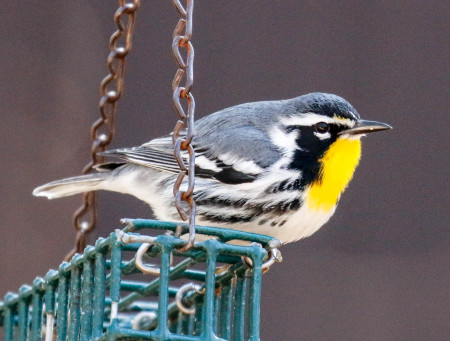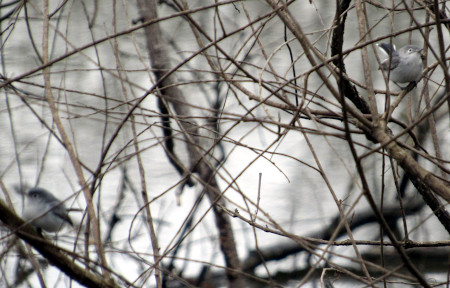2019 Chapel Hill (NC) Christmas Bird Count Summary
Rarities on the 2019 Chapel Hill CBC!

This Yellow-throated Warbler returned to the Driscoll's suet feeder for the third year in a row! Amazingly, they also had a Yellow-throated on the 2009 CBC, which may have been the same bird!

Brian Bockhahn spotted this pair of Blue-gray Gnatcatchers at Jordan Lake.
|
The Sunday 22 December 2019 Chapel Hill Christmas Bird Count was near average in number of species (87, ten-year average 87.5), but not in number of individual birds. Indeed, our total of about 29,564 is the highest in 45 years and the second-highest in the 90 year history of the count! Driving our numbers were a huge stream of Double-crested Cormorants headed south, observed by Roger Shaw at the northern edge of Jordan Lake, and some big flocks of grackles. Roger did his best to count the number of birds in the flock, which streamed past him for 30 minutes, and came up with an estimate of 9000. The Jordan Lake count two weeks later also had an unprecedented number of corms, estimated at 6000. On a birds per party hour basis, it was an outstanding count, with 192 versus an average of 105, our second highest. However, for species other than cormorants and blackbirds, it was slightly below average.
Rarities this year were highlighted by a pair of Blue-gray Gnatcatchers, found by Brian Bockhahn at Jordan Lake, our sixth count record, and a Fish Crow (Vern Bothwell, Joe Donahue), our fifth. Both are becoming more common winter residents as our climate warms. Tom and Barbara Driscoll had our 7th Yellow-throated Warbler in their yard, well photographed. This is no doubt the same individual that they hosted last year and the year before. Yellow-throated Warblers winter regularly in South Carolina and may become more regular here in winter. Continuing this trend, an amazing four parties had single Black-and-white Warblers, only our eighth count with them and a record high.
Other goodies included a Northern Pintail (Nan Dewire and party), 2 Bufflehead (Shelley Theye and Lee Van Malssen), a Northern Bobwhite (Steve Backus and Sebastian Burgess), Common Yellowthroat (Roger Shaw). We usually miss both of these duck species; Bobwhite is only our second since 2007, though they were seen almost every year through 1990.
We set a surprising number of record highs: 9000 Double-crested Cormorants (previous high 400 in 2006, average 77), 9 Cooper's Hawks (8 in 2004 and 2013, average 4.5), 70 Red-shouldered Hawks (57 in 2012, average 37.5), 88 Red-headed Woodpeckers (previous high 87 in 2014, average 45), 325 Red-bellied Woodpeckers (287 in 2014, average 211), 110 Yellow-bellied Sapsuckers (ties 2014, average 63), 242 Downy Woodpeckers (195 in 2013, average 139), 529 Chipping Sparrows (506 in 2008, average 301), and 4 Black-and-white Warblers (3 in 1984, average 0.4). We also set a record high for all species of woodpeckers combined, 949 (921 in 2014, average 616).
Also in good numbers: 5 Black Ducks (average 0.6), 123 Killdeer (average 60), 117 Bonaparte's Gulls (average 65), 538 Tufted Titmouse (2nd highest, average 427), 66 Winter Wren (2nd highest, average 40), 585 Carolina Wren (2nd highest, average 400), 286 Ruby-crowned Kinglet (average 130), 20 Eastern Meadowlark (average 9), 62 Brown-headed Cowbird (average 30), 6861 Common Grackle (average 316), 641 Northern Cardinal (2nd highest, average 499).
Our big miss this year was Savannah Sparrow, the first miss since 1967.
A few other species were remarkably scarce this year: Canada Goose (238, average 453), Pied-billed Grebe (3, average 9), Turkey Vulture (67, average 195), Red-tailed Hawk (19, average 30),
American Goldfinch (238, average 433, lowest since 1996), Yellow-rumped (Myrtle) Warbler (121, average 299, lowest since 1989).
Top honors for highest number of species this year goes to Jan Hansen, who found 61 species at University Lake and Old Greensboro Highway. For extra credit, Jan started owling at 2:39 am, maybe the earliest start ever! Roger Shaw tallied the greatest number of individual birds, with 9530, thanks to that huge flock of cormorants. Also worthy of mention: Steve Backus and Sebastian Burgess became the first Chapel Hill CBC participants to count by boat, paddling up two arms of Jordan Lake.
Weather: Temperature 28-48 F, wind calm, 0-3 mph, cloudy, water open. Effort: 52 observers in 26 field parties, 153.8 party hours (140.25 by foot, 9.05 by car, 4.5 by boat) and 190.95 party miles (98.6 by foot, 86.45 by car, 5.9 by boat), 7.1 hours and 12.2 miles owling, 2 people and 34.3 hours watching feeders.
Thanks to all the participants for your help!
-- Will Cook, compiler
Full results in PDF format
Chapel Hill Bird Club

